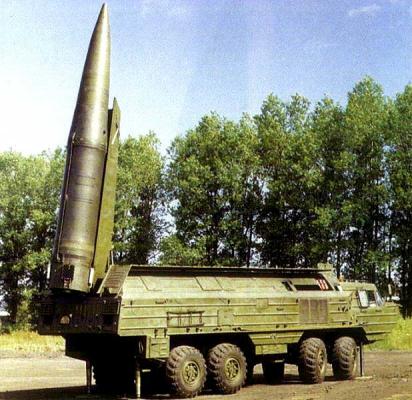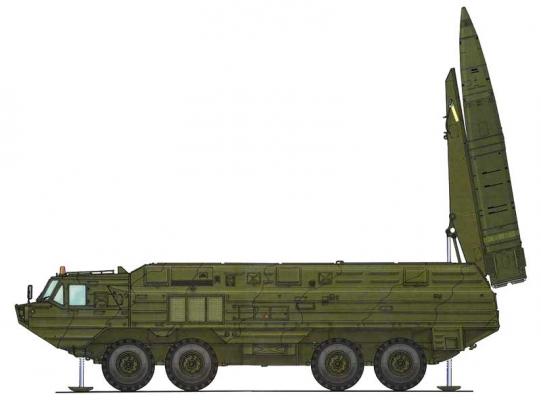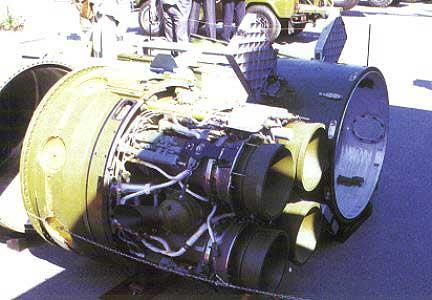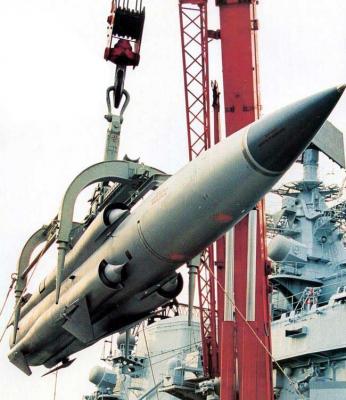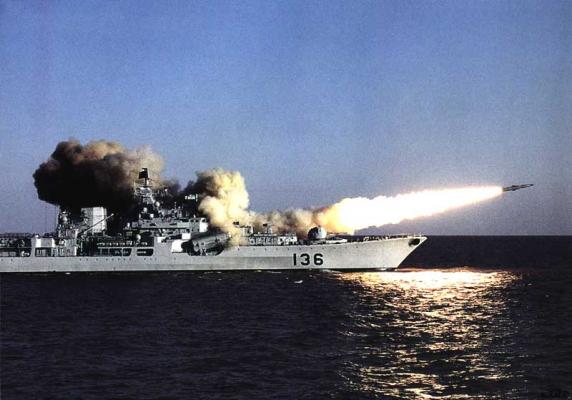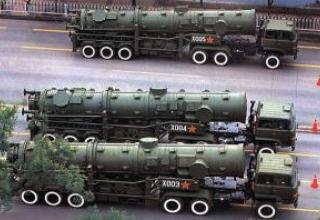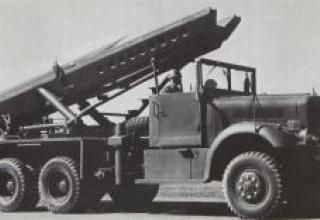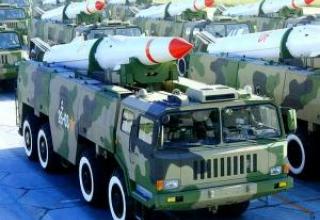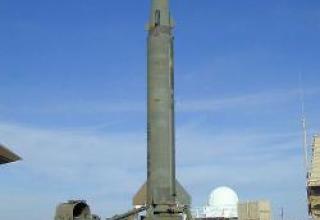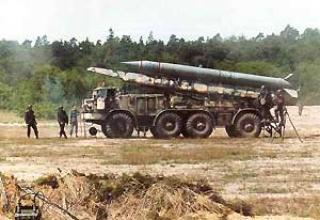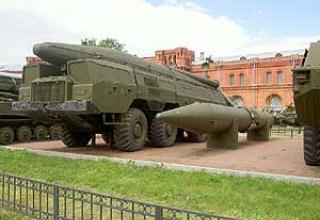Operative-tactical missile system 9K714 "Oka", developed at the Mechanical Engineering Design Bureau (Kolomna) under the leadership of Chief Designer of the Invincible S.P., was to replace the complex 9k72 in the Army-Front line. The first launches of "Oki" were made in 1976, the complex was adopted in 1983.
In GostsNIRTI under the leadership of Igor Kupriyanov for the missile "Oka" was created a set of means to overcome missile defense. In the early 1980s two systems were adopted for service in the USSR and the USA - "Oka" and "Patriot". The use of the Patriot anti-aircraft missile system against the Oka ballistic missile system, which was equipped with head protection means, would have been completely ineffective. After it was adopted into service with Oka, the Patriot air defense system lost the quality of its anti-missile weapons.
The Oka missile system was unique and had no analogues in the world according to the adopted technical decisions and their execution.
In December 1987, Gorbachev and Reagan signed the Treaty between the USSR and the USA on the Elimination of Mid- and Short Range Missiles (MRMS). The assessments of this document are very controversial. It stopped the continental nuclear arms race and reduced the threat to the USSR posed by American forward-based facilities. At the same time, due to a number of political mistakes made by the Soviet leadership, the weapons system, vital for the defense capability, was placed under restrictions. The first of these was the Oka, which appeared in the treaty under the index OTR-23. In 1989, over 200 missiles and 102 launchers were destroyed.
It should be noted that the package of documents related to the RSMD Treaty did not specify the range of the Oka. This was not accidental. The missile had never been tested for a range greater than 400 kilometres and, in accordance with this generally accepted criterion, should not have been placed among the restricted systems. Its inclusion in the Treaty was not objectively justified.
In 1987, work on the Oka-U missile, which was already ready for testing, was discontinued. The Oka-U missile differed from its predecessor in its significantly higher accuracy, wide range of combat equipment, and its ability to be used as part of reconnaissance and strike systems.
However, with the destruction of the "Oka" in the USSR its history did not end. Only after the collapse of the Soviet Union it turned out that 18 such installations remained in Germany, the same number - in Bulgaria, about a dozen - in Slovakia, and four - in Romania. The USA easily agreed with Germany on the destruction of SS-23, but the negotiations with Romania and Slovakia took a long time. Bratislava proved to be especially persistent: while the power in the country remained in the hands of Vladimir Mechiar, Slovakia did not want to hear about the abandonment of its missile ambitions. And only the complete change of the Slovak leadership in the autumn of '98 and the subsequent announcement of the intention to join NATO in 2002 led to the destruction of these complexes.
In the west, the complex was designated SS-23 "Spider".
Composition:
The complex consists of:
- missile 9M714;
- launcher (PU) 9P71 (photo1, photo2, photo3, photo4, photo5)
- TZM 9T230 transport and charging machine;
- transport machine 9T240 ;
- control and testing machine 9B69;
- auxiliary equipment.
9M714 - Solid fuel single-stage missile with detachable warhead. The missile body is made of reinforced carbon plastic with a thermal protection coating. The combat units are of different types (the 9M714 missile could be equipped with a nuclear warhead of 10-50 kilotons capacity). The missile with conventional BC had index 9M714K, with nuclear 9M714V. The docking of the missile part with the head unit was made on special latches with clips, which at separation of the head unit were twisted by pyropatrons. Head units were changed at the starting position within 15 minutes. The 9M714 missile was equipped with a turbo-generator power source.
The missile's control system is autonomous, inertial, with an on-board digital computer system. The command and gyroscopic device is a gyrostabilized platform, where the angle sensors are used as sensors of angular velocities and accelerations, and as sensors of lateral velocity, as well as for the initial horizon of the platform are used NIS - zero speed indicators. In the lower part of the platform there is a prism, which is used to accurately aim the missile. The meaning of the aiming process is to combine the plane of flight of the missile, which is the aiming plane, with the direction of the target. The sighting of the "Oki" takes place in the horizontal position of the missile and represents a turn of the gyrostabilized platform of the command and gyroscopic device to the calculated angle. Before the launch, the missile's control system is coupled with the PU navigation system. Aiming is performed in two stages. At the first stage, the servomotor turns the platform to an angle, which is the difference between the direction direction direction of arrival of the launcher (coincides with the axis of the rocket) and the direction angle of the target. In the second stage, the platform is accurately rotated relative to the nearest prism edge of the command and gyroscopic device. After the launch, the missile rehearses the entered angle, turning in the flight towards the target. The firing sector for the "Oka" is 180°, i.e. the missile can turn left or right after the launch in the direction of the target at an angle of up to 90°.
At the starting point of the trajectory, the 9M714 missile developed 4 times the speed of sound. At the starting point of the trajectory, the engine nozzles were rotated and the lattice aerodynamic rudders at the tail end of the missile were operated. The height of the ballistic trajectory at the highest point reached 120 km. The control system made it possible to control the flight of the missile throughout its entire length, the head part was separated on the descending section of the trajectory in dense layers of the atmosphere. In the descending section of the trajectory, the missile's flight speed reached 10M, with the head end falling almost vertically to the target after separation. The high trajectory, high flight speed, and the availability of a missile defense system made the task of intercepting the 9M714 missile practically impossible.
Complex "Oka-U" could be used as part of a reconnaissance and strike system, in this case, the target designation for the launcher comes directly from an intelligence source (eg, an aircraft for long-range radar reconnaissance), which allows for rapid redirection of the missile.
Along with the above mentioned distinctive features of "Oki" were: short time for launch preparation, autonomy of combat vehicles, high degree of automation of prelaunch preparation, quite high efficiency of non-nuclear combat equipment application.
PU 9P71 and TZM 9T230 are of the same type and are made on self-propelled chassis BAZ-6944. In the front part of the BAZ-6944 hull there is a control cabin, behind it - the engine compartment, the rest of the hull is occupied by a cargo compartment. The engine compartment is equipped with a V-shaped diesel engine UTD-25 with an output of 400 hp. The torque from the engine to the wheels is transmitted through a transmission that implements onboard power flow distribution scheme. The transmission consists of a five-stage hydromechanical transmission, two-stage transfer gearbox with an interboard differential, cardan gears, final drives and wheel gears. The transmission scheme also includes a differential mechanism that eliminates the rigid kinematic relationship between the wheels of the front and rear bogies of each side. The machine has eight driving wheels with wide profile tires of variable pressure. Suspension of all wheels is independent torsional. Wheels of the first and second pair are controllable. The car is able to overcome water obstacles. The movement of the car is carried out by two water-jet engines.
All starting equipment was inside the fighting vehicles. Communication equipment and top fasteners, sighting system and test launching equipment were operated by 3 persons. The cockpit navigation and sighting system is displayed on a tablet, where the location of the launcher is indicated by the intersection of two lines and the coordinates are displayed on a scoreboard. Preparedness to launch from the march was less than 5 minutes. The rocket is lifted to the vertical position in 20 seconds. The work of onboard equipment and hydraulics of the launcher was possible both from the marching engine and from a separate diesel power unit located above the third axis, which through a clutch was connected to the hydraulic pump. When the engine was not running or in an emergency, a manual hydraulic pump could be used to open the upper sashes of the rocket compartment and lift the guide rail without a rocket.
The missile was transported by the 9T240 transport vehicle in a special container 9Y249 separate from the combat unit. Container 9J251 was used to transport the combat unit.
Characteristics:
| Oka Rocket Complex | |
| Year of adoption | 1983 |
| Developer | Kolomna Machine Building Design Bureau |
| Manufacturer | Votkinsky Machine Building Plant |
| Rocket 9M714K / 9M714B | |
| Number of steps, pcs. | 1 |
| Maximum diameter, m | 0.970 |
| Length, m | 7.516 / 7.315 |
| Missile launch weight, kg | 4630 / 4400 |
| Range of fire maximum, km | 400 / 300 |
| Range of fire is minimal, km | 50 |
| Maximum height of the trajectory, km | 120 |
| Firing accuracy (CWO), km | 0.35 |
| Weight of combat unit, kg | 715 / 375 |
| Launching machine 9P71 / Transport and charging machine 9T230 | |
| Wheel formula | 8x8 |
| Gross weight,kg | 29100 / 29985 |
| Length, m | 11.760 / 11.800 |
| Width, m | 3.130 / 3.000 |
| Height, m | 3.000 |
| Speed on land, km/h | 65 |
| Speed afloat, km/h. | 8-10 |
| Power reserve, km | 700 |
| Power of the engine UTD-25, HP | 400 |
Testing:
Tests of "Moskit" complex started in June 1978 at "Sandy Beam" range. The flight and design tests began with two throw launches on June 9 and October 10, 1978. The mock-up of the rocket was equipped only with the starting engine. Both launches were normal. Then came a long break, mainly due to the unpreparedness of the material part of the rocket, in particular, the marching engine, which was difficult to be brought to the manufacturer.
On December 29, 1979 a model equipped with a marching engine was launched. The launch was unsuccessful, as the marching engine was not launched, and the starter remained in the nozzle block of the marching engine after development. After the start, a timeout was taken again to rework the marshal engine. The next launch took place only on July 3, 1980. The task of the launch was to get a reliable start of the rocket and make a flight at an altitude of about 20m. The launch was considered to be successful, but the marching engine never reached the design mode.
January 27, 1981 the rocket "Moskit" for the first time was launched in full configuration, but without turning on the active channel combined CNS. The rocket was to hit the target SM Pr.1784 at a distance of 38 km. The launch was unsuccessful due to instability of the onboard control system. At launch on April 28, 1981 a task similar to the previous launch was set. Direct hit to the target was achieved. On June 2 there was shooting at two targets - SM pr. On June 2 there was firing at two targets - SM Pr. 1784 and BKShP No. 436 bis at the distance of 38 km without switching on the active channel of combined GSN. The launch was successful and a direct hit to a larger target, SM, 1784 Pr. was achieved.
By the beginning of June 1981 a new modernized target SM Pr.1784 arrived to provide flight tests of ZM-80 missiles. 1784M Prospect, manufactured in Nikolaev. On this target, as well as on the old SM Ave. The whole system of radar reflectors in the amount of about 50 pieces of different types (K-0.7, K-1.25, etc.) and a thermal imitator "Balancer" working on household gas propane-butane were left on this target, only instead of one burner there were two (it was believed that a big ship - a battleship, a cruiser or an aircraft carrier - had at least two radiation centers). The target of the CM Ave. At the SM target of 1784M Ave. the system of external trajectory measurements was fundamentally improved. Previously, the film camera and photo equipment, shooting the missile approach to the target, were installed "on the eye", and now the film camera was tied to the target itself with a high degree of accuracy. The camera viewing angles were chosen so that they necessarily included some element of the target structure in addition to the missile. In order to test the operation of the active channel of the combined RS on a ZM-80 missile on the SM target, the cameras were designed to be able to detect the target. 1784M was equipped with a special system called "Minaret". The system included "Don" radar with a modified antenna system, remote control system for television signaling and telecommunications, equipment for documentation of operating modes, etc. In addition, two "Puck" and "Rynda" systems were installed, which determined the missile miss rate. The "Puck" system determined the magnitude of the miss relative to its antenna, and the "Rynda" system determined the magnitude of the miss relative to the so-called "reduced target". The target also had a well-equipped cockpit to accommodate the team. On June 26, 1981, two targets were fired - SM Pr.1784M, set from the starting point at a distance of 40 km, and on the BKShchina Pr.436 bis, set from the starting point at a distance of 10 km. The missiles were launched with active and passive CNS channels connected. The launch was considered successful. The missile hit the SM target at 436bis Ave. 1784M (pierced the target grid at 1.0m from the deck) and was driven 80km from the launch point. This launch ended the program of flight and design testing of the Moskit complex.
Launches under the program of joint (state) testing began in August 1981. At this stage of testing, the missiles were launched both from the coastal launcher and from a large missile boat of project 1241.1 (plant № 402) and destroyers of project 956 "Modern" (plant № 861) and "Desperate" (plant № 862). The first launch under the joint testing program took place on August 21 from the coastal launcher on target SM of 1784M pr.1784M to the range of 102 km. The task of the launch was to check the operation of all units and assemblies. Direct hit to the target was achieved. On September 30 it was launched from the boat of project 1241.1. The model of the rocket was equipped only with a starting engine. The mock-up was launched normally from the boat, which ran at a speed of 24 knots. when the sea waves 2-3 points. After that, the boat with the factory number. 402 was allowed to participate in joint testing of the Moskit complex.
On October 2, 1981 the launch was made with the task similar to the launch on August 21, but this time the target was not exposed. The launch was considered successful.
On November 24th the boat of project 1241.1 was launched from the target of SM Pr. On November 24th it was launched from the boat of the project 1241.1 on the SM target of 1784M pr. for the range of 100 km. The launch ended in failure due to a malfunction in the onboard control system. The rocket fell into the sea on the 10th second after the launch.
On December 27, 205 and 305 missiles were fired in volley from the boat of 1241.1 Ave. at two targets - BKShchinskaya Ave. 436 bis and SM pr. 1784М. The distance to the target of the BKSh was 10 km. Missile No 205 was aimed at this target. The launch was considered successful - a direct hit to the target was achieved. The range to the SM target was 33km. Missile No. 305 was to be aimed at this target. The launch was unsuccessful - the covers of the air intakes of the marching engine did not open, and the missile was brought to 23.7 seconds of flight. The interval between launches was 5 seconds.
On April 14, 1982 the missile was launched from the shore-based installation on the target of the SM Ave. 1784M Ave. at a distance of 100 km. The launch was unsuccessful. The missile fell at the 24th km distance due to malfunctions in the onboard control system.
On April 29, the first launch from the destroyer of the project 956 "Modern" in the Northern Fleet on the target of OS-111 (trawler project 265K) at a distance of 141 km was made. The launch was successful - a direct hit to the target superstructure was achieved. May 26, 1982 volley firing of rockets № 106 and № 505 from the destroyer "Modern" on the target of OS-111 at a distance of 35.5 4 m was carried out. Both missiles with equipment for the combat unit TC-22 were simultaneously launched from both sides of the destroyer. Rocket number 505 hit the target, hitting its superstructure. Rocket number 106 did not lower the flight height in front of the target, flew over it at an altitude of 17 m from the waterline and flew 47.5 km. The shooting was found to be partially successful. But the rocket number 106 could have flown not 17 m above the waterline, but 170 m, still with the presence of TC-22 ship would not have seemed a little Yankee.
On August 31, 1982, it was launched from the boat of project 1241.1 at a distance of 100 km with a 50-target position after the launch from two targets of OS-111 and SM pr. 1784М. The launch was unsuccessful - the marching engine was not launched and the missile fell into the sea at a distance of 12.8 km from the boat.
September 15 was a repeat of the previous launch. On September 15, it was a repeat of the previous launch. 1784M Ave. and hit it. The actual range of fire was 107.7 km.
On September 29 the boat of project 1241.1 was launched from the boat to the range of 27 km at the target of OS-1.11. A direct hit was achieved, the target sank.
November 28, volley firing of rockets ¹ 306 and ¹ 506 was made from the destroyer of project 956 "Desperate" in the Barents Sea in the Northern Fleet. (Shots were fired in parallel with the ship's delivery tests.) The target range of the target was set at the SM Ave. 1784 was 27 km. The speed of the ship during the launch was 20 knots. Firing was carried out from the starboard launcher, the interval between launches was 5 seconds. The target was hit by both missiles.
This was the end of the joint testing of the Moskit complex. In the course of these tests conducted 15 launches (14 missiles and 1 mock missile). According to the decision of the State Testing Commission, there were 8 fully successful launches, 5 partially successful launches and 2 unsuccessful ones.
In the period from 1983 to 1988, there were three types of tests of the Moskit complex. Firstly, tests on improvement of tactical and technical characteristics, ZM-80 missiles were conducted. In total, there were three launches: March 11, 1983, June 29, 1983. (mock missile) and December 7, 1984. At this stage, the flight range of 125 km was achieved.
Since the early 1980s, the possibility of installing the Moskit complex on the Lunar screen of Project 963 was considered. For this purpose, a mock-up of the screen plan of project 903 was installed at the "Sandy Beam" range in the village of Chernomorsk. The main purpose of the tests was to check the ability of the screen plan design to withstand the force and heat of the starting engine jet. On October 5 and December 21, 1984 two launches of "Moskita" mock-ups equipped only with starting engines were held. The first launch was made from the right container of the bow pair of launchers, and the second launch - from the left container of the tail pair of launchers. Since there were only two containers, the nose pair stood in its place at the first start and then it was moved to the tail. During these tests were tested two options for loading missiles on the screen, the first version of the rocket was loaded into a container already installed on the screen, using the loading device, the second version of the rocket was loaded into a container located on the ground, and then the entire structure was installed on the screen. All launches went smoothly. After the first launch 9 tiles were damaged, after the second one - 2. There were two launches of ZM-80 missiles in the Caspian Sea. The target was the BKShchy Ave. 436bis. The first launch was unsuccessful due to crew errors. During the second launch there was a double salvo (at an interval of 5 seconds). The launch was counted as successful.
